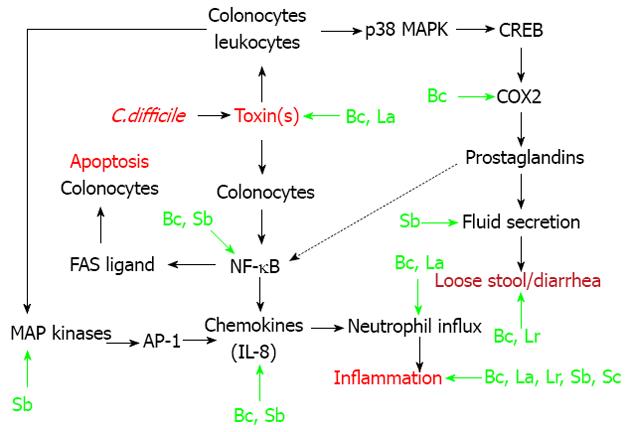Copyright
©2013 Baishideng Publishing Group Co.
World J Gastrointest Pathophysiol. Aug 15, 2013; 4(3): 47-52
Published online Aug 15, 2013. doi: 10.4291/wjgp.v4.i3.47
Published online Aug 15, 2013. doi: 10.4291/wjgp.v4.i3.47
Figure 1 Immunomodulation by probiotics for Clostridium difficile-associated disease.
Clostridium difficile (C. difficile) associated toxins (red font) engage colonic epithelial cells (colonocytes) leading to nuclear factor-kappa B (NF-κB) activation, interleukin (IL)-8 production, neutrophil influx and inflammation. These toxins also bind to receptors on colonocytes and leukocytes leading to p38 mitogen activated protein kinases (p38 MAPK) and cyclic-AMP response binding protein (CREB) activation. CREB, through cyclooxygenase 2 (COX2), is critical for the production of prostaglandin E2. In turn, this prostaglandin plays an important role in the fluid secretion/diarrhea associated with CDAD. C. difficile associated toxins also lead to the activation of other MAP kinases (ERK 1/2) and activator protein-1 (AP-1), which also plays a role in IL-8 production. There is also cross talk (dotted line) between the various pathways. For example, prostaglandin E2 can stimulate Fas ligand expression and apoptosis in colonic epithelial cells. The green arrows in this figure represent specific points of intervention by certain probiotics, resulting in immunomodulation by these agents. The abbreviations indicate the specific probiotics, which can modulate these signal transduction pathways. These probiotics (green font) include: Saccharomyces boulardii (Sb); Bacillus coagulans GBI-30, 6086 (Bc); Lactobacillus acidophilus (La); Lactobacillus rhamnosus (Lr); and Saccharomyces cerevisiae, strain 905 (Sc).
-
Citation: Fitzpatrick LR. Probiotics for the treatment of
Clostridium difficile associated disease. World J Gastrointest Pathophysiol 2013; 4(3): 47-52 - URL: https://www.wjgnet.com/2150-5330/full/v4/i3/47.htm
- DOI: https://dx.doi.org/10.4291/wjgp.v4.i3.47









